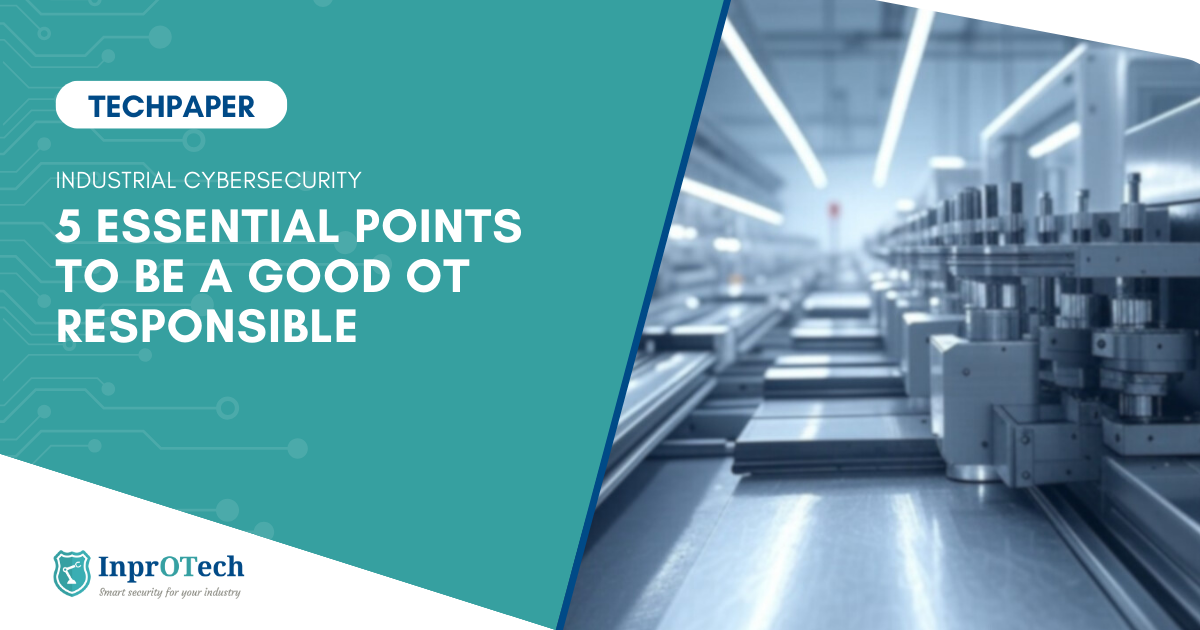As is well known, OT environments (“OT” stands for Operational Technology) and industrial cybersecurity are two fundamental concepts in the field of security; not only when talking about critical infrastructures, but in the protection of industrial systems in general.
OT environments refer to systems and devices used to control and monitor operations in industrial environments such as power plants, chemical plants, water supply networks and manufacturing systems. These environments include technologies such as industrial control systems (ICS), automation systems, sensors and actuators, and specialized equipment. The primary goal of OT environments is to ensure that industrial processes operate safely and efficiently.
Every company that operates in the environments described above should have a good OT manager. This sector of companies are the usual target of attacks coming from both inside and outside the environment. Examples include the successful cyber-attack on LNG producers just before Russia’s invasion of Ukraine, the temporary shutdown of 14 Toyota factories after a supplier was compromised, or the breach of the ICS and SCADA systems of a well-known nuclear power plant. Therefore, we must recognize that it is not enough to try to separate the production areas of our business, as this is neither an efficient nor, in most cases, an effective solution.
Exploring the complexities and scope of OT environments has facilitated the identification of numerous potential risks. As a result, we now know that defense systems against these potential attacks, implemented on their own, are mostly inefficient, saturating security teams with surplus information that they do not know how to manage and failing to prioritize alerts according to risk, context and potential impact. These solutions alone do not mitigate risk or prevent malicious attacks that affect business continuity and industrial operations if they are not placed in the hands of qualified personnel who know how to interpret and configure them properly.

Consider all areas and elements affecting the OT network
Most of the solutions available on the market lack a complete perspective of the risks that arise in the OT environment and of all OT-IT-IIoT assets. A holistic view is essential.
For example, considering the sole and exclusive use of an IDS (Intrusion Detection System), we need to be aware that the visibility of our asset inventory is likely to be quite poor. It is necessary to supplement this information with data from other security and industrial sources to have a complete view of all OT assets and ensure effective risk mitigation; we must be aware that security teams cannot fix what they cannot see. Therefore, in addition, we must consider the following:
- The business impact of each asset, operational context, and organizational hierarchy
- Visibility of security controls
- Industrial sources such as OPC, DCS, and project files
- Firewalls
- Web proxies
- Detailed views of each asset and its security configurations
- Management systems
- Servers
- Network devices and IDS/IPS
- SIEM
- Coverage of the operational network
Be attentive, proactive, and assess contextual risk
A good OT manager must ensure that vulnerability management is carried out correctly, and have the ability to reduce the risk of potential breaches, since acting after an attack would be too late.
It must be able to reduce the operational attack surface of an organization through appropriate segmentation, helping to limit the areas exposed to potential attacks, making it more difficult for cybercriminals to access.
It must also know how to mitigate vulnerabilities in OT-IT-IIoT environments, identifying and fixing security flaws before cybercriminals can exploit them.
Knowing how to harden critical assets and systems against ransomware is key to protecting the organization’s most valuable and sensitive assets from being encrypted or hijacked.
It should be open to receiving practical recommendations to implement preventive measures and improve the resilience of systems against possible attacks, anticipating risks.
Finally, it is important to be vigilant and ensure continuous backup of critical systems to guarantee their recovery, as there is never a guarantee that unauthorized access can be completely blocked.

Develop a strategy to reduce potential risks
Since most SOC analysts are lacking in OT skills and operational teams, another essential feature of providing effective industrial cybersecurity solutions is to give these teams clear, accurate and easy-to-use mitigation guidelines.
These guides should be appropriate for operational environments where downtime is not an option. The goal is for analysts and operational personnel to be able to use the guides without needing to be cybersecurity experts, while these tools should be adjustable to the specifics of each organization’s industrial environment.
Mitigation guides should provide context for training operational and security teams to immediately reduce OT network security exposures and vulnerabilities. We must keep in mind that simple patching may not be sufficient, or even possible, especially for legacy OT systems. Therefore, the use of mitigation guidelines strengthens the operational resilience of an industrial organization against cyber risks.
Increase ROI in OT security investment
Regardless of the OT security tools that our organizations are already using, they must provide a comprehensive assessment of security controls. In other words, they must provide valuable, detailed and efficient information, while filtering out the useful solutions from the rest that would yield more delayed results.
Improving ROI also allows optimizing ideas in the TO area by ranking them according to their priority level.
Knowing that our focus is industrial cybersecurity, the teams must have an operational vision focused on the prevention of risks and security breaches. This forces us, if we want to be good OT managers, to have flexible ideas and to adapt according to the needs of the moment and the business. Being proactive with risks will avoid unforeseen expenditures to remedy breaches that should not have occurred.
Continued collaboration between IT and OT
One of the main challenges today is the lack of alignment, or even total disconnect, between OT and IT teams. Since both depend on each other to operate efficiently, a good OT manager must play the role of liaison between the two, facilitating risk mitigation and ensuring fast and effective responses to security incidents.
In order to develop effective collaboration, they need to work within a known context. Security teams need to understand the security risks impacting operations, the level of damage and the pathways through which they act. In addition, both the OT and IT teams need to be empowered to make decisions and have flexibility within the organization’s bureaucratic processes.
All teams must separate, within the rules established for their roles, the “high priority” alerts from the rest, as well as know what actions are required to mitigate such risks.
A good OT manager should encourage coordination of the two teams so that they benefit from a platform that allows them to collaborate transparently and effectively, develop the ability to delegate tasks and track departmental progress. Organizations should consider the differences in the teams’ existing workflows, allowing them to easily and effectively integrate OT security tools and processes, which will help improve collaboration between stakeholders.
InprOTech helps you to be a better OT manager
At InprOTech, we understand the challenges faced by an OT manager in an increasingly complex and connected environment. Therefore, if you are looking for support to train and become a better OT manager, we offer solutions specifically designed to strengthen your management and optimize your results in each of the key aspects of your responsibilities.
Contact us here and find out how we can boost your potential as an OT manager.



